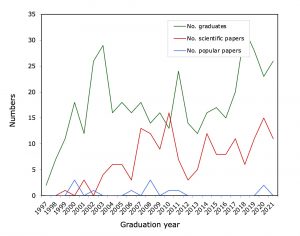Over 450 students have graduated from the Bristol Masters, and we welcome a new class of about 30 students each September. We summarise here the background to the degree, our former graduates, and our aims.
History
The programme was established in 1996, and ran first with a combination of undergraduate, and some, postgraduate units. As student numbers built up, income covered the salary for a tutor, and we moved to more than 80% M-level teaching. Successful completions of the programme are indicated below.
Each year, many Masters projects from Bristol are published, thanks to the hard work and skills acquired by the students, and strong encouragement from supervising staff and postdocs (and these include one in Nature and three in Science). Full listings of the publications are given here.
 (Left) Plot showing numbers of students graduating each year from the MSc, and number of refereed and other publications.
(Left) Plot showing numbers of students graduating each year from the MSc, and number of refereed and other publications.
Until 2017, the programme attracted 40-50 applicants each year, and some 15-25 enrolled – in 2017 and 2018, the number of enrolled students rose to 30. These include ten or twelve overseas students each year, and we have welcomed students from Austria, Belgium, Canada, China, Ecuador, Finland, France, Germany, Greece, Iceland, India, Ireland, Italy, Japan, Latvia, Mexico, Netherlands, Spain, Sweden, the United States, and Venezuela.
Graduates of the Bristol MSc in Palaeobiology go on to study for a PhD in all continents, and especially in Europe and North America, and others use the qualification as an entrée to work in museums or other professional posts in education, publishing, the media, and commerce.
Key characteristics of the Bristol MSc
- The programme is taught by the eight core palaeobiology staff in Bristol, with key contributions from staff in the Biology and Archaeology Departments, as well as from Bristol postdocs and PhD students, and visiting lecturers from elsewhere, where relevant.
- We have established a network of collaborators who co-supervise MSc research projects on materials in the Natural History Museum London, Bath Royal Literary & Philosophical Institution, Bristol City Museum, the Ulster Museum, Manchester Museum, Warwickshire Museum, University College Dublin, University College Cork, the Jurassic Heritage Coast, Nova Scotia Museum, New Brunswick Museum, and many others. In total, 54 different people (internal and external) have been involved with project supervision.
- A strong emphasis is placed on publication of student research, and MSc projects are now generating many papers in top-rated international journals each year (see graph above).
- Students regularly use state-of-the-art research facilities, including our Nikon CT scanner, a tomography suite with ten work stations, physical fossil preparation equipment, acid digestion facilities, phylogenomic laboratories, taphonomy experimental laboratories, and others.
- MSc students are provided with practical advice and help in securing travel funding for their MSc work, and each year, MSc students secure ten or more grants from external funding agencies, and further help from the Bob Savage Memorial Fund.
- The MSc acts as an important draw to bring excellent young researchers into the Palaeobiology Group, where they collaborate with the existing staff and researchers. For those who are interested in going on in research, we encourage some to stay in Bristol, and assist others to secure PhD positions, from Cambridge (UK) to Cambridge (USA).
- The programme is thoroughly international, and is placed in an internationally-oriented earth sciences department. This provides a mix of ideas and a mix of practical advice for students who wish to work with colleagues around the world, or secure a PhD position.
- In all recent surveys, the Department of Earth Sciences in Bristol rates in the top three in the UK, and it is well regarded internationally: there are currently some 70 postdocs and fellows in all earth sciences disciplines in the Department, most from overseas. The Bristol Palaeobiology Research Group was identified in 2017 as the best palaeontology research group in the world in the first discipline-specific annual review by the Center for World University Rankings. The score is based on publications over the past ten years, assessed according to total numbers and the Eigenfactor and Article Influence Score of the journals.
External examiners
In the UK, the quality of all degree programmes is maintained by constant interchange of personnel among universities, and especially by the appointment of an External examiner (EE). The role of the EE is to monitor the programme structure, discuss course content with the staff, examine question papers, and scrutinise marked work. Importantly, the EE acts as the student voice: s/he meets the students independently and gathers their opinions and suggestions which s/he then delivers to the University centrally and any issues have to be resolved.
We have been fortunate over the years in appointing some leading palaeontologists from other institutions to take the role of External examiner. For the record, these are:
| Professor David Siveter | University of Leicester | 1996/7 – 1998/9 |
| Professor Tony Hallam | University of Birmingham | 1999/2000 – 2001/2 |
| Professor Chris Paul | University of Liverpool | 2002/3 – 2004/5 |
| Professor Richard Fortey FRS | Natural History Museum | 2005/6 – 2007/8 |
| Dr Paul Taylor | Natural History Museum | 2008/9 – 2010/1 |
| Professor Dianne Edwards FRS | University of Cardiff | 2011/2 – 2014/5 |
| Professor David Harper | University of Durham | 2015/6 – 2017/8 |
| Professor Matthew Wills | University of Bath | 2018/9 – |

